August 23, 2013
Air Date: August 23, 2013
FULL SHOW
SEGMENTS
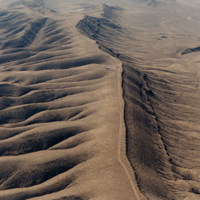
Nuclear Power Storage Crisis
View the page for this story
The Fukushima disaster in Japan is grabbing headlines, but the United States has a nuclear problem on its hands as well. Host Steve Curwood talks with Ed Lyman from the Union for Concerned Scientists, about what the United States can do with all the nuclear waste from its power stations. (06:20)
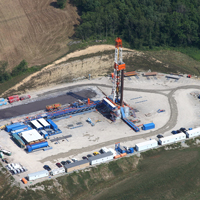
Climate Risks from Leaky Natural Gas Wells
View the page for this story
In April, the EPA lowered its estimates for how much of the powerful greenhouse gas methane leaks from natural gas wells to the atmosphere but the number remains, at best, an estimate. Cornell professor Tony Ingraffea joins host Steve Curwood to talk about how difficult it is to solve the problem of leaking methane. (06:00)
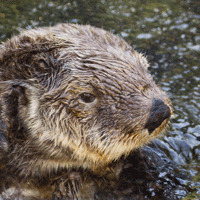
Otters As Climate Defenders
/ Steve CurwoodView the page for this story
According to two scientists at the University of California at Santa Cruz, a small animal could have a big impact on climate change. Professor Chris Wilmers explains to host Steve Curwood that sea otters could be key to preserving kelp forests, one of the world’s great carbon sinks. (06:10)
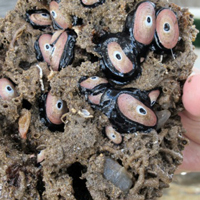
Nature's Help for Cancer Vaccines
/ Lauren SommerView the page for this story
Researchers in Southern California are cultivating an unusual marine mollusk that could prove vital to the future of cancer vaccines. Lauren Sommer reports as part of the EYE-TRIPLE-E Spectrum Magazine, National Science Foundation special, "The New Medicine: Hacking Our Biology". (08:00)

BirdNote ® – Snail Kite – Bird of the Everglades
/ Michael SteinView the page for this story
Michael Stein describes a unique Florida bird whose survival depends on the ebbs and flows of the region’s wetlands. (02:15)
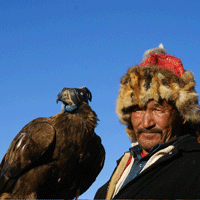
Eternity of Eagles
View the page for this story
Stephen Bodio is a naturalist, falconer, and writer whose travels have taken him all around the world. During the 1990s, he lived with Kazakh tribes of central Asia, who use eagles to hunt wolves. Bodio discusses with host, Steve Curwood his new book a compendium of all things eagle called An Eternity of Eagles. (10:25)
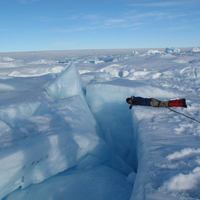
Greenland Melt Music
/ Emmett FitzGeraldView the page for this story
Greenland's 2012 summer ice melt was the largest on record. Ice specialist Marco Tedesco visits Greenland every year and, tired of trying to convey the science of the melting ice with graphs and statistics, he found someone who could turn his data into music. Living on Earth’s Emmett FitzGerald has the story. (07:40)
Show Credits and Funders
Show Transcript
Host: Steve Curwood
Guests: Edwin Lyman, Tony Ingraffea, Chris Wilmers, Steve Bodio,
Reporters: Lauren Sommer, Emmett Fitzgerald
[THEME]
CURWOOD: From Public Radio International, this is Living on Earth.
[THEME]
CURWOOD: I'm Steve Curwood. Nuclear waste is out of sight, out of mind for most of us...but Congress needs to act before it’s safely and permanantly stored away. Also, a humble marine mollusk with a big medical future --
LINCICUM: So I’ll show you some of our up-and-coming limpets right here. So, if we take a look in this tank, these guys are fairly slow growing, but you can see them. These guys are about three and a half years old or so.
CURWOOD: The keyhole limpet may be the key to new vaccines. And, using music to explain Greenland’s melting ice sheets.
PERL: When you take the time to actually listen to it, you experience what's actually happening in a way that is more visceral, and has a different kind of impact then if you just look at a graph.
CURWOOD: Art in partnership with science to tell the story of our changing climate. We’ll have that and more this week, on Living on Earth. Stick Around!
[NEWSBREAK MUSIC: Boards Of Canada “Zoetrope” from “In A Beautiful Place Out In The Country” (Warp Records 2000)]
ANNOUNCER: Funding for Living on Earth comes from Stonyfield Farm, makers of organic yogurt, smoothies, and more.
Nuclear Power Storage Crisis
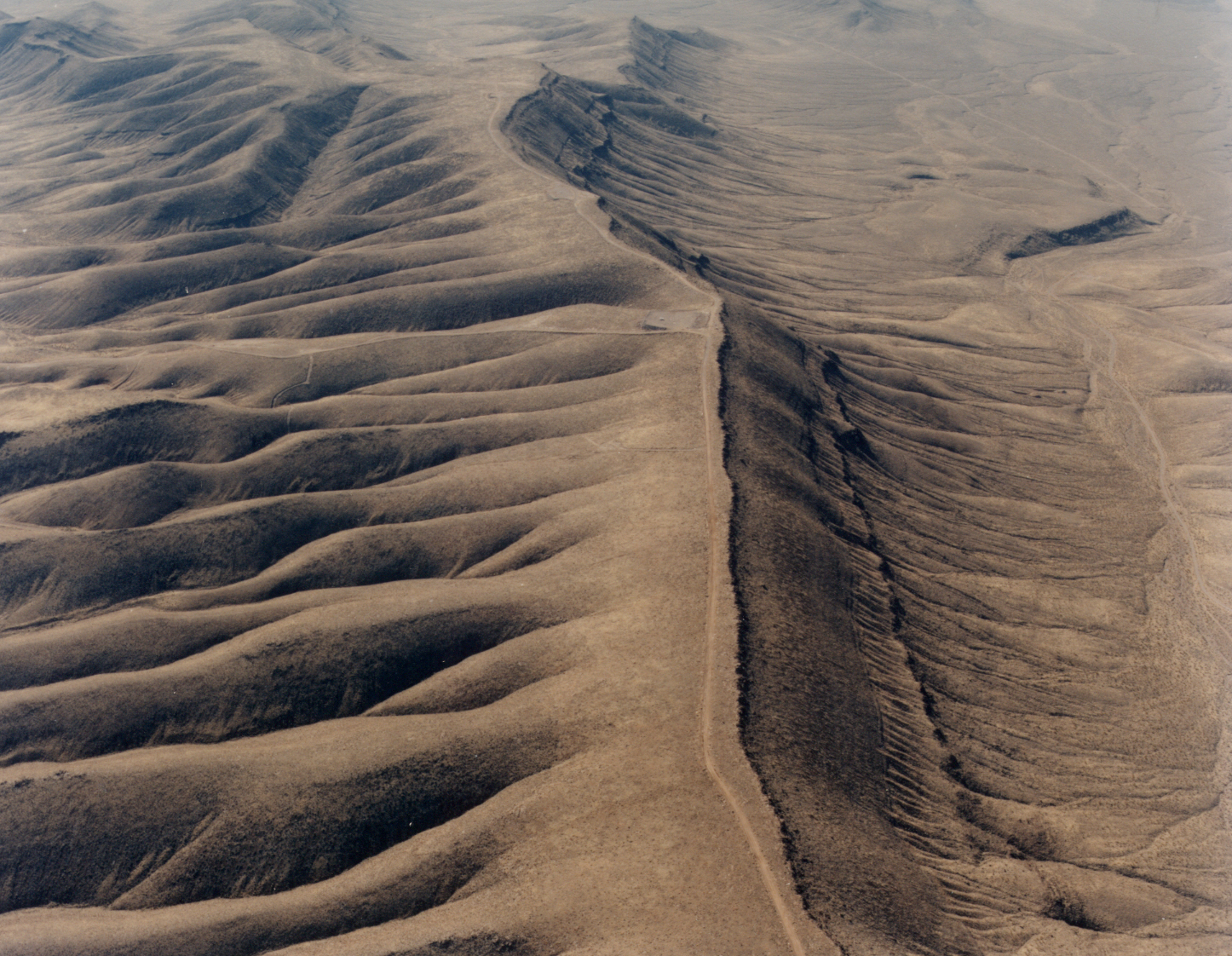
Yucca Mountain, Nevada (photo: US Department of Energy)
CURWOOD: From the Jennifer and Ted Stanley Studios in Boston, this is Living on Earth. I'm Steve Curwood. It’s been two and a half years since a tsunami severely damaged the Fukushima nuclear power complex in Japan and authorities are still struggling to contain the radioactivity from the related meltdown. Now they are reporting some 300 tons of highly contaminated water has leaked into the ground, prompting them to issue the gravest warning since the early days of the disaster. This news prompted us to look at the US nuclear power program, particularly the unsettled question of what to do with tons of radioactive spent fuel. Back in the 1980s, Yucca Mountain in Nevada was chosen as the nation's nuclear waste dump, but widespread resistance has stalled the project. The waste is still with us, though, and Ed Lyman, the nuclear expert at the Union of Concerned Scientists says that's a problem.
LYMAN: The Department of Energy was supposed to take title to the nuclear waste generated at nuclear power plants by 1998. That hasn’t happened, and that waste is continuing to accumulate at dozens of reactor sites around the country today.

Ed Lyman (photo: Kiwhan Chung)
CURWOOD: Without the Yucca Mountain project, where else can nuclear power operators in the United States turn for nuclear waste storage?
LYMAN: Well, unfortunately, the process for siting a location for a geologic repository has to be started all over again, and that’s what the Obama administration has proposed. But what they’ve said is that the process that chose Yucca Mountain in the first place was so fatally flawed that we need to take lessons from that experience moving forward. At the time when the law was passed, Nevada was a very politically weak state, and the other states simply ganged up on and said you have to take this repository. Well, that didn’t work so well, and now the tables have turned with Senator Harry Reid as the most powerful person in the Senate. So political winds change, but waste remains. And so the problem is how do you find a politically and technically equitable solution that will achieve the goals of securing this waste for the hundreds of thousands of years it needs to be secured.
CURWOOD: So, let’s talk about where our nuclear waste, that is from nuclear power plants, is currently being stored.
LYMAN: Well, there are more than sixty operating reactor sites, each of which has substantial quantities of nuclear waste, and there are a number of shut down reactors as well, which have legacy spent fuel as well. These are scattered all over the country—most reactor sites are east of the Mississippi, but there are quite a few in the West as well. Most of the spent fuel is stored in swimming pool type structures called spent fuel pools. These are concrete, steel-lined pools filled with water, and the fuel is submerged under there. However, many of these pools have been overstuffed over the years because there’s been no place to send them outside of the reactor sites.
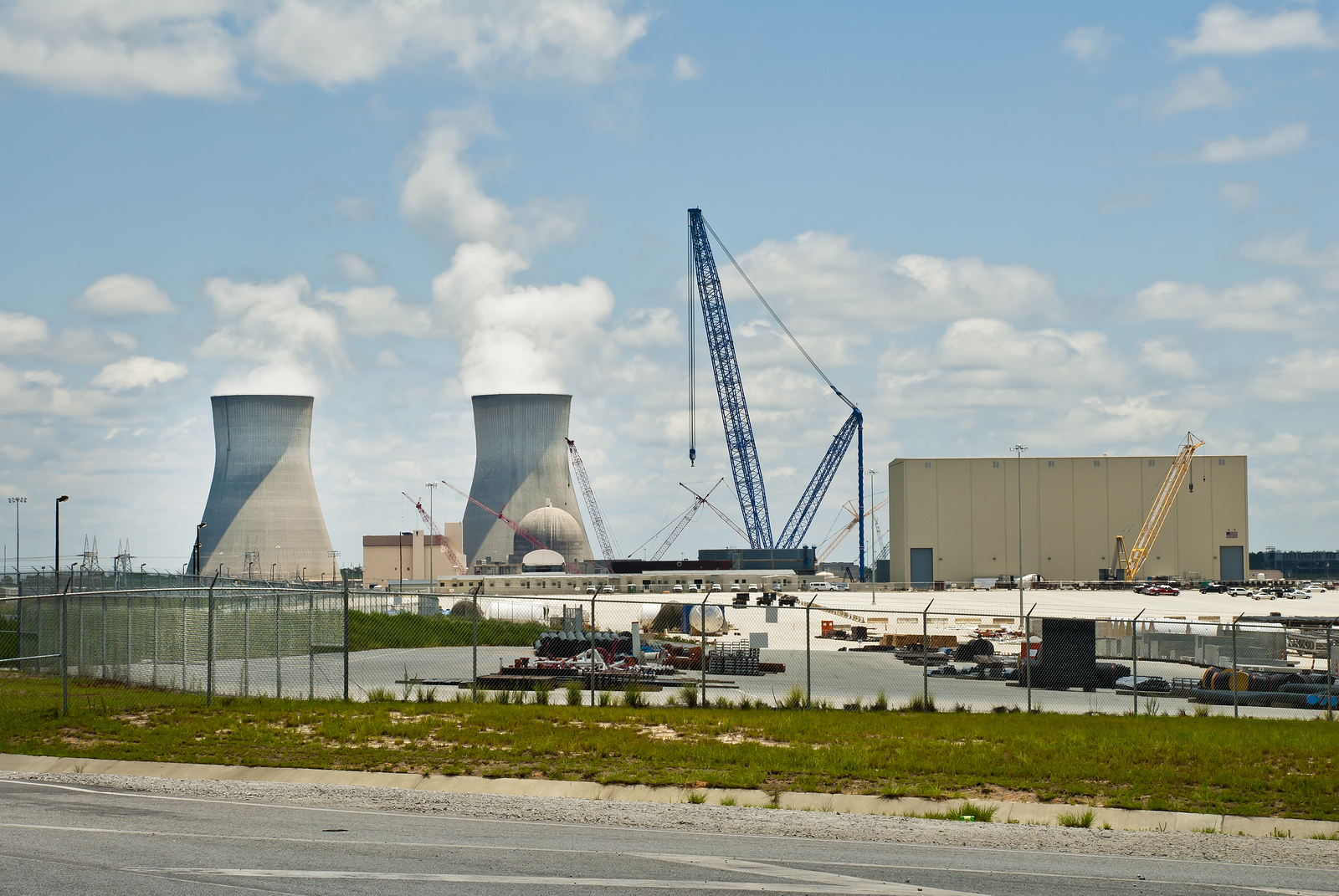
Vogtle Nuclear Generating Station, Georgia (photo: Bigstockphoto.com)
CURWOOD: How secure are these cooling pools?
LYMAN: The pools themselves have a lot of problems, especially now that they are stuffed well beyond their original design capacity. The biggest threat is if there’s an event that causes a rapid loss of water from a pool, like a large earthquake or even a terrorist attack that could breach the pool liner. If the water level goes below the tops of the fuel assemblies, then there’s a potential that they could heat up and actually catch fire, and then you could have a very large release of radioactivity from one of these pools. Now the utilities have started to build what they call dry casks, which are concrete and steel casks which are set out on a parking lot, and once fuel has been cooled for several years, it’s safe to be stored in these casks.
CURWOOD: Now as I understand it, when the tsunami hit Fukushima and led to the meltdown in one of the reactors there, there was a moment where they might have lost control of their cooling pools as well?
LYMAN: Yes, actually they did lose control. In fact, one of the reactors, unit 4, lost a great deal of water for some reason at the beginning and it took them several days to find a way in which they could start getting water back into the pool. So if they were not able to do that successfully, then there is the possibility that unit 4 could have had the type of fire that I talked about. But what we have to remember is that the US spent fuel pools, on average, have much much more waste in them than even the unit 4 pool at Fukushima.
CURWOOD: What are the public health risks of all this nuclear waste from power plants?
LYMAN: Well in the event of a fire in a spent fuel pool, you could actually have a larger release of Cesium 137 than we saw even during the Fukushima disaster. And we could actually cover an area of probably hundreds of square miles with contamination. Ultimately you could have tens of thousands or hundreds of thousands of people exposed to unacceptable radiation levels. The Nuclear Regulatory Commission’s own recent study found that you could have potentially hundreds or thousands of cancer deaths resulting from such an accident. So it really is imperative that we move spent fuel into safer dry-cast storage as soon as possible to reduce the risk of a large release like that.
CURWOOD: Now in an attempt to deal with some of these issues there’s a bipartisan group of senators who have submitted a bill called the Nuclear Waste Administration Act. Could you describe that legislation for us? What it would do if it were enacted?
LYMAN: That legislation would create a new authority for managing nuclear waste outside the Department of Energy, which a lot of people believe is necessary to make progress. It would actually begin the process for what’s called consent-based citing, for both consolidated interim storage sites above ground and a geologic repository in the future. But one has to be very careful that you don’t have a process which is essentially bribing a disadvantaged community to take nuclear waste. I mean from an ethical point of view, that’s very questionable.
CURWOOD: Edwin Lyman is a senior scientist at the Union of Concerned Scientists. Thanks so much for taking the time today.
LYMAN: Thank you for talking to me.
Related links:
- The Union of Concerned Scientists’ nuclear blog
- Check out Ed Lyman’s page at UCS
Climate Risks from Leaky Natural Gas Wells
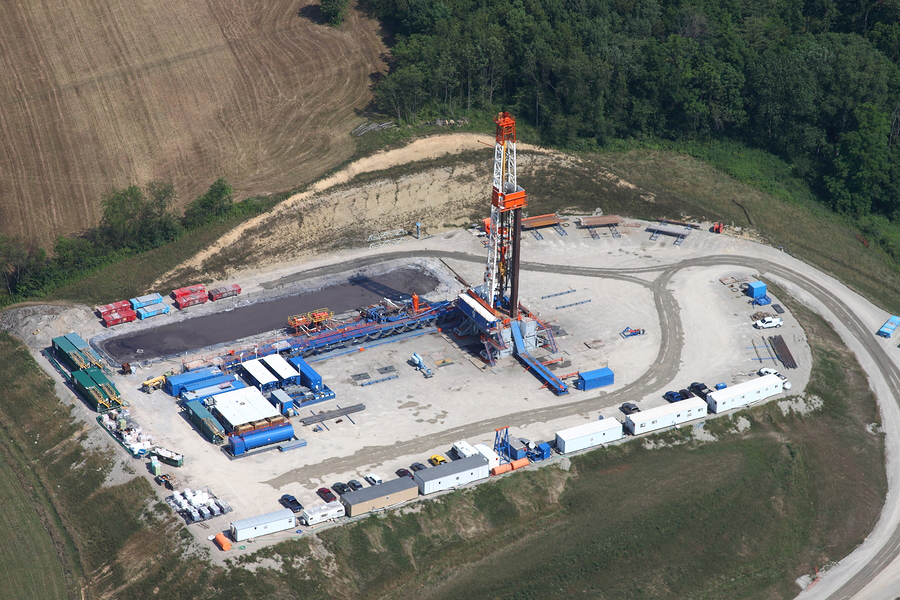
This natural gas well delivers gas from the Marcellus shale to the earth’s surface for use in transportation and power production (Photo: bigstockphoto.com)
CURWOOD: Now, President Obama has touted natural gas as a valuable bridge fuel to transition to renewable energy. But there's a catch the President doesn't mention -- the methane that leaks from oil and gas wells. Methane is about 25 times more powerful than CO2 as a global warming gas, and nobody knows for sure how much of it is actually leaking. Well, Tony Ingraffea is trying to find out. He's a professor of civil and environmental engineering at Cornell University.
His lab models the failures that lead to methane leaks. Welcome to Living on Earth!
INGRAFFEA: Good to be with you Steve, thank you!
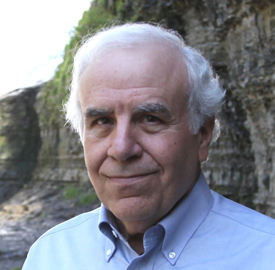
Cornell professor Tony Ingraffea researches how natural gas wells fail and how to measure the methane that leaks out (Photo: Tony Ingraffea).
CURWOOD: So, tell me, why is it so difficult to figure out just how many natural gas wells are leaking?
INGRAFFEA: There are approximate 4.2 million oil and gas wells in North America alone, and although many of those that are recent are inspected, it’s very difficult to keep up with that kind of a backlog. We don’t really have a count for how many are leaking and more importantly, we don’t have a measure of how much methane is leaking form all those leaking wells.
CURWOOD: Now you’ve asserted that natural gas wells are leaking at a dangerous rate but the EPA reported back in April that production related methane emissions are actually down even as the amount of drilling has skyrocketed. What do you make of this?

Steel casings such as these are set end to end, sealed with a bit of cement to prevent leakage (Photo: bigstockphoto.com).
INGRAFFEA: Let me rephrase your question. The EPA reported that their estimates of EPA emissions are down. Neither the EPA nor any objective independent entity has ever measured methane emissions across the board. We do not know. It’s a, the analogy, although not perfect, is that you’re balancing your checkbook this month but you don’t know how much you started with. So you can deceive yourself into thinking your checkbook is balanced – you know how much came in this and how much went out that month – but at the end of the month you really don’t know how much money you have in the bank.
CURWOOD: So what’s the small percentage of escaping methane that obviates the advantage of natural gas, in your view?
INGRAFFEA: If that leak rate is anything more than about 2% of the total production of natural gas, then there’s no benefit, there’s certainly no immediate benefit to changing over from coal to natural gas for electricity generation.
CURWOOD: So how realistic is it to think that we can build a natural gas well without leaking methane?
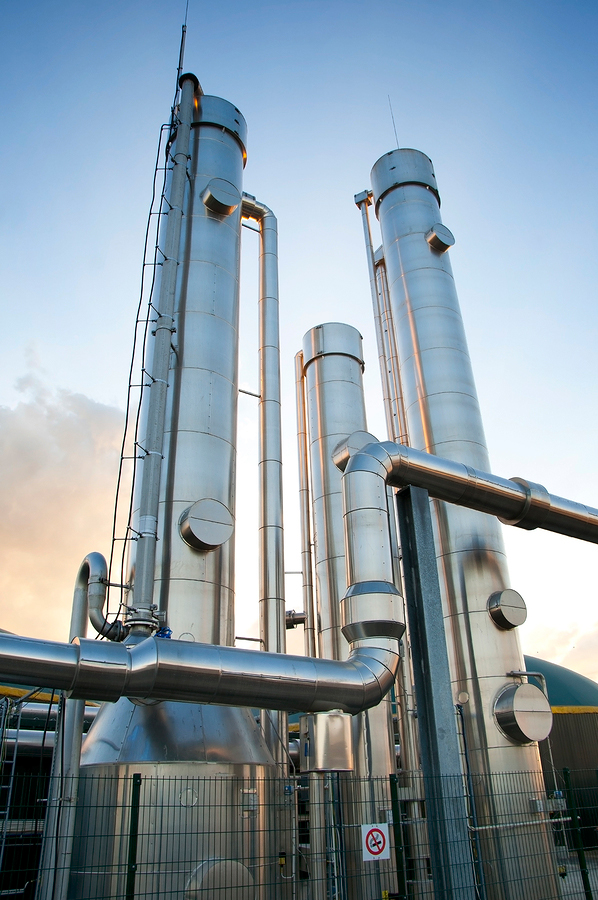
A natural gas power plant cuts down on carbon dioxide emissions but may increase more potent methane emissions (Photo: bigstockphoto.com).
INGRAFFEA: It’s not realistic at all to assert that any oil or gas well can be constructed and maintained in such a way over its lifetime without it ever leaking.
CURWOOD: Why?
INGRAFFEA: Any human made structure will eventually degrade to a point where it’s no longer maintaining its original designed function.
CURWOOD: What’s the fundamental vulnerability of a well?
INGRAFFEA: The most vulnerable part of a well is the cement in the well. So you drill a hole through rock and you place in that hole steel pipe called casing. Think of them as concentric straws for example. And between each layer of steel casing you have to put a gasket. Otherwise what’s down hole can come up between those layers of steel. So that gasket material is very important. And the current technology is to use hardened cement paste. A typical shale gas well’s total length could be 3-4 miles and that gasket is only between an inch and two inches thick. If a substantial part of it cracks, as cement is prone to do, then you have a potential gap in that gasket.

Natural gas wells may leak methane into the atmosphere through cement gaskets, which connect one steel casing to the next (Photo: bigstockphoto.com).
Coming back to that issue of how long does a well have to live, from an industry point of view, the well is useful as long as its in production – as long as its producing oil and gas. From an environmental point of view, the well has to last forever. Otherwise it leaks forever.
CURWOOD: So how much methane is escaping through these leaks? I know it’s only an estimate but what do you figure?
INGRAFFEA: I don’t know. We don’t know. As far as I know, nobody knows. It’s crucial to understand here that we don’t know where many of those wells are. Those millions of wells around the world, that drilling began over a century ago. Records back then weren’t nearly as good as they are today. So a very large percentage of those millions of wells are called lost and abandoned. This is an unsolved problem.
CURWOOD: You wrote an op-ed in the New York Times not so long ago saying that natural gas is starting to look like less of a bridge to future technology and more of a gangplank. What do you mean and what’s the solution?
INGRAFFEA: Well I’m a civil engineer, so I know bridges. A bridge is a man-made structure which has an abutment at one end where you’re standing and an abutment at the other where you’re trying to get to. And the bridge is a structure that’s supposed to save you from falling into what’s in between where you are and where you’re going.
So the analogy that’s often used by the industry, by politicians, and even some green groups – that natural gas is a bridge to the future—makes no logical sense. Because in this case, the bridge, which is supposed to take you over something you don’t want to fall into, is composed of something you don’t want to fall into: natural gas, which is a fossil fuel. So the longer that we keep increasing the production of any fossil fuel, like gas or oil from shale, the longer that we’re making the ravine, the river, the gulf that we’re trying to get across. So in that sense, it is a gangplank. We might not ever finish the bridge. We might get halfway across and we’ve run out of climate change time.
CURWOOD: Tony Ingraffea is an engineering professor at Cornell. Tony, thanks so much for taking the time with me today.
INGRAFFEA: Steve, it was great to be with you. Thank you for the honor.
Related link:
Tony Ingraffea
[MUSIC: Evers: Andrew Bird “Give It Away” from Break It Yourself (Mom & Pop Records 2012)]
CURWOOD: Coming up – Heading to the shore-line – in search of vaccines and warriors against climate change. That’s next on Living on Earth!
[CUTAWAY MUSIC: Davell Crawford: “The Cat” from The B-3 And Me (Bullseye Blues Records 1998)
Otters As Climate Defenders

A sea otter in the Vancouver Aquarium (Photo: Imtiaz333 Flickr Creative Commons)
CURWOOD: It’s Living on Earth, I'm Steve Curwood. Sea otters are cuddly, cute and playful, but research from the University of California at Santa Cruz claims they could also hold one of the keys to mitigating climate dosruption. Two scientists from UCSC have demonstrated the crucial role that sea otters play in the health of one of the ocean’s great carbon sinks, kelp forests.
If we want to sequester more carbon from the atmosphere, they say, we need more otters.
Joining us now from the University of California at Santa Cruz is Chris Wilmers, professor of Environmental Studies. Professor, welcome to Living on Earth.
WILMERS: Thank you, glad to be here.
CURWOOD: So, sea otters as climate warriors - what made you think to connect the otter with climate disruption?
WILMERS: Well, I do a lot of work on the effects of predators more generally on ecosystems. And one thing we’ve been seeing for a long time now is that predators can have a dramatic impact on plant populations through their intermediary impact on their prey. So, when otters eat sea urchins, which are their main diet for instance, we see kelp forest bounce back to life. And my research has also focused a bit on climate change and so I thought I wondered if there was a connection between the two.
CURWOOD: So, explain to me your study and the specifics of the findings that you have.
WILMERS: Well, over 40 years or so, my co-author and colleague Jim Estez has been looking at the effect of sea otters on coastal ecosystems. And what he’s shown over that time period is that when you have otters, you have these abundant kelp forests. When you remove otters, the kelp forests disappear. And what’s novel about this study is that we looked at… how that influences carbon. And what we found is that there’s a dramatic draw-down of carbon from the atmosphere when you have sea otters and all that underwater kelp using that carbon.

Kelp beds protected by otters absorb 12 times more carbon dioxide than those that are thinned out. (Photo: Saspotato Flickr Creative Commons)
CURWOOD: And what’s the mechanism? I mean, the sea otters are related to urchins are related to kelp… explain that for me please.
WILMERS: So sea otters eat sea urchins. When you have sea otters around, you have fewer sea urchins and the ones that you do have - they sort of hide in the crevices between rocks. If you get rid of the sea otters, the sea urchins come out of the crevices, start crawling around on the sea floor, eating all the kelp they can find, their populations increase and the kelp declines to nearly nothing.
CURWOOD: So currently what is the population of sea otters and what would a healthy population look like?
WILMERS: Well, the area that we were doing our work is mainly the Aleutian Islands, but then also the coast of North America down to the Canadian/US border. And in that area, there used to be probably a few hundred thousand sea otters. That population has declined dramatically over the last 20 or 30 years by a somewhat mysterious switch in feeding patters by killer whales.
CURWOOD: Killer whales?
WILMERS: Killer whales, yeah! So, the theory is that killer whales used to eat primarily the large baleen whales. And after World War II there was a tremendous increase in whaling which depleted most of the large baleen whales over much of the north Pacific. So by the 70s or 60s there were very few baleen whales remaining.
And so the killer whales that remained switched to a new food source - and that turned out to be harbor seals. And then they depleted harbor seals so they switched to feeding on fur seals. And then they depleted fur seals and they switched to feeding on Steller sea lions. And, they depleted the Steller sea lion populations so finally the switched to feeding on otters. They drove the otter population down from a few hundred thousand to just a few thousand.
CURWOOD: So, intensive whaling is indirectly connected to more climate disruption.
WILMERS: Yeah, in a sense you could say that. There’s been a sort of chain of cascading events that initiated back in the 1950s with heavy whaling.
CURWOOD: Given the current population of otters and their appetite for sea urchins that would otherwise eat kelp, how much carbon do you think that they are helping stay sequestered - what might that be worth on the international carbon exchanges?
WILMERS: Well, we did a calculation in our study using the current price of carbon on the European carbon market. And we valued the amoun of carbon that sea otters indirectly sequestered using that value and it came out to be somewhere in between 205-400 million dollars, just in the carbon sequestered by the living kelps themselves.
CURWOOD: How might you use that dollar amount to affect the status of sea otters?
WILMERS: Well, the hope would be that you could use that money to reintroduce sea otters and restore the kelp forests. Right now, carbon markets are very young and they’re still evolving and I’m not sure that you could actually sell that carbon on the market today. But, as those markets evolve, we hope that there will be mechanisms to do that kind of thing and that kind of money could be used to figure out how to reintroduce otters or restore them to historic populations and get back all that carbon into the ocean.
CURWOOD: So, what do you hope will come out of this research?
WILMERS: I think one of the main things that I hope will come out of this research is the influence that animals can have on the carbon cycle. So far most of the carbon cycles don’t incorporate animals - they incorporate plants, certainly - but animals have been largely overlooked because it’s been assumed that they are bit players in the carbon cycle. But what I think this study shows is that the role of animals can be quite significant, and that ecologists more generally should be looking the world over for roles that animals might be playing in other kinds of ways in other kinds of ecosystems that influence the carbon cycle.
CURWOOD: Chris Wilmers is a Professor of Environmental Studies at the University of California at Santa Cruz. Thank you so much for taking this time today!
WILMERS: Thank you!
[MUSIC: Jimi Hendrix “Hey Gypsy Boy” from People, Hell & Angels (Sony Music 2013)]
Nature's Help for Cancer Vaccines

California limpets (photo: Spectrum Magazine)
CURWOOD: Think medical breakthrough, and you're apt to picture a high-tech lab with gleaming steel equipment. But medical advances can also come from nature, such as the seaside.
In Southern California, researchers have found a way to grow an unusual marine mollusk that may play a major role in future vaccines. Lauren Sommer went to explore this unique laboratory site - her story comes to us from the EYE-TRIPLE-E Spectrum Magazine, National Science Foundation special, "The New Medicine: Hacking Our Biology".
[SFX: OCEAN WAVES]
SOMMER: When you think of cancer treatment, this probably isn’t the scene you’d imagine. But this rocky strip of land in Port Hueneme in Southern California is home to a unique medical facility.
LINCICUM: So, what you’re seeing right now is - this is our primary production seawater system. Essentially, we pump nutrient-rich seawater right over here from the port. We really just remove big particulate matter before it flows into our production tanks.
SOMMER: Brandon Lincicum is the aquaculture manager for Stellar Biotechnologies. We’re standing next to large tanks just a stone’s throw from the Pacific Ocean.
LINCICUM: Take a look at some of these guys. OK, so, this is what you’ve been waiting to see. This is Megathura crenulata right here, the giant keyhole limpet.
SOMMER: Lincicum reaches into the tank and pulls out a round, purplish animal that looks like an abalone.
LINCICUM: They do have a hard shell, but they have this mantle tissue that they can fold up over their shell so you know, when you touch these guys, they are almost soft. It’s almost...
SOMMER: A little slimy.
LINCICUM: A little slimy? Right? A little bit.
SOMMER: The limpet he’s holding weighs almost a pound, but it takes years for them to grow this large.
LINCICUM: So I’ll show you some of our up-and-coming limpets right here. So, if we take a look in this tank, these are our limpets, and these guys are fairly slow growing, but you can see them. These guys are about three and a half years old or so. We produce these guys from sperm and egg—microscopic sperm and egg. These guys are teeny tiny.
SOMMER: This is the only place in the world where giant keyhole limpets are bred and grown. And there are thousands here, each with their own unique tracking number. The question is, why?
OAKES: It pretty much is a nondescript member of the local California coastal environment but turns out to be really important when it comes to medical technology.
SOMMER: Frank Oakes is the CEO of Stellar Biotechnologies. He says what’s special about giant keyhole limpets is their blood—or more specifically, something found in their blood called KLH.
OAKES: Keyhole limpet hemocyanin. And then, hemocyanin is the protein from the blood, analogous to hemoglobin in humans.
SOMMER: This unique blood protein, KLH, has been studied since the 1950s, and it’s played a major role in immune system research. But the keyhole limpet is only found in Southern California, which means there’s a limited supply.
OAKES: It was harvested routinely for extraction of its blood, and with little regard to understanding the animal, its importance in the wild, or the perishability of the wild population.
SOMMER: Oakes has a background in aquaculture, so he began studying how to breed limpets in captivity.
OAKES: In the late 1990s, we started work on developing nonlethal extraction methods for the animal, so we can take the blood without killing them.
SOMMER: Getting limpets to grow in captivity was no easy task. Oakes had to learn how to coax them into reproducing. He had to learn what conditions they grow best in. And because the limpets are part of medical research, there has to be strict quality control to prevent contamination. Today, thousands of limpets go through their entire life cycle in a controlled system, giving blood several times a year.
OAKES: From a 50-animal lot, we get about a liter of serum. And from that liter of serum, we will typically produce about 20 grams of protein. And at retail value, that 20 grams of protein for us is approximately $100,000.
SOMMER: Why would a blood protein be so valuable?
CHOW: Without it, a lot of the vaccines will not work.
SOMMER: Herb Chow is a vice president at Stellar Biotechnologies. He says to understand why KLH is useful, you have to go back to the early days of vaccines. Medical researchers would take something harmful like a virus, kill it, and then inject it into your body. Your immune system would see the inactive virus and it would learn how to attack it.
CHOW: Except if you use the dead virus or dead bacteria, it does accomplish that activation or stimulation, but it comes with a price. The price is some level of toxicities: People get sick because the toxin is still there.
SOMMER: So researchers took viruses apart, pulling off the small chunks that your immune system could attack. They injected those smaller pieces as the vaccine, but there was a problem.
CHOW: Just too small. They don’t see it. So it becomes stealth to your immune system.
SOMMER: And like a stealth plane, if your body doesn’t see it, it can’t learn to attack it. But attach those virus pieces to KLH, and it’s like attaching reflectors to the plane.
CHOW: By putting two together, all of a sudden the radar starts seeing it.
SOMMER: And your immune system mounts an attack or starts making antibodies. KLH itself is neutral and doesn’t harm you. Chow says it’s being used in vaccine research for Alzheimer’s and autoimmune diseases. It’s also being used in cancer vaccine research.
CHOW: The problem with the cancer cells is a lot of the antigen that are expressed on the cancers is actually your own tissues. The body sees them: This is my own, I shouldn’t react to it.
SOMMER: Cancer cells are, in essence, your own cells. So your immune system doesn’t see them as foreign invaders.
CHOW: And, as such, it fools your immune system to kind of ignore them and let them keep growing. And when the tumor mass gets to be a certain size, then your body no longer be able to handle it.
SOMMER: So doctors use treatments like radiation and chemotherapy, which target all fast-growing cells in your body. But Chow says that’s why cancer vaccines have such promise.
CHOW: It’s something that it’s high on the radar screen because of the characteristics - that they can differentiate the normal cells from the tumor cells and be able to target the treatments to the tumors.
SOMMER: Cancer vaccines could train your body to only attack the cancer cells. Chow says the challenge is finding something on cancer cells that would help your immune system differentiate them from your own cells.
CHOW: And there are differences, and it used to be we are looking at differences on the cell surface, and it seems like that difference is not big enough. There are some differences, now we’re going inside the cells, looking a lot - zillions of molecules inside the cells - and you find more differences.
SOMMER: Today, most of the cancer vaccines that use KLH are still in the research phase or in clinical trials. But CEO Frank Oakes says the role of KLH is looking promising.
OAKES: The long-term commercial demand for KLH looks very promising because it’s a key ingredient in a wide variety of drugs that are currently in clinical development.
SOMMER: The challenge is that vaccines take decades to develop - and not all of them come to market.
OAKES: Unfortunately, in this business, more drugs fail in clinical development than succeed.
SOMMER: But Oakes says with the growth in cancer vaccine research, there’s a good chance that this mollusk from Southern California will eventually play a role in keeping us healthy. In Point Hueneme, I’m Lauren Sommer.
CURWOOD: Lauren's story on the Keyhole Limpet comes from the IEEE Spectrum Magazine, National Science Foundation special, "The New Medicine: Hacking Our Biology".
Related links:
- Spectrum website
- Stellar Biotechnologies website
BirdNote ® – Snail Kite – Bird of the Everglades

CURWOOD: Nature likes to go with the flow, but sometimes people get in the way with their bird-brained ideas.
[BIRD NOTE® THEME]
CURWOOD: In this week’s Birdnote, Michael Stein takes us to one place where the natural flow has been disrupted.
[SFX: CALL OF THE SNAIL KITE AND EVERGLADES AMBIENT SOUNDS]

Male Snail Kite with an Apple Snail. (Photo: © Tom Grey)
STEIN: When Florida became a state in 1845, the legislature declared the Everglades - America’s largest wetland - totally worthless. But today, we know how important wetlands are. They soak up storm water. They remove toxic chemicals that contaminate drinking water. And they’re home to a bird called the Snail Kite, which in the United States is found only in south Florida.
[SFX: CALL OF THE SNAIL KITE AND EVERGLADES AMBIENT SOUNDS]
STEIN: Over the years, the slowly flowing “River of Grass” has been replaced by a series of reservoirs with little water movement. The remaining Everglades are only half their original size. Before we altered them, they filled during the summer rainy season, and gradually dried out during winter and spring.
The aptly named Snail Kite feeds only on the Apple Snail. But the snails don’t flourish in places that are permanently under water. They do best with seasonal wet and dry periods, and flowing water.

Female Snail Kite in flight (Photo: © Tom Grey)
So, the Snail Kite is endangered in the Everglades, because most remaining habitat is too wet and stagnant. The kite, like the snail, depends on variable flows and wet and dry seasons. It’s a classic boom and bust species - one that thrives when wetlands are allowed to function in a natural way. I’m Michael Stein.
[SFX: CALL OF THE SNAIL KITE AND EVERGLADES AMBIENT SOUNDS]
CURWOOD: There are some photos of Snail Kites on our website - LOE - dot - org.
Related links:
- Bird sounds provided by The Macaulay Library of Natural Sounds at the Cornell Lab of Ornithology, Ithaca, New York. Snail Kite recorded by G.Vyn and M.J. Fischer. Corkscrew Swamp Sanctuary (Audubon) adjacent to Everglades, recorded by G. F. Budney.
- BirdNote® Snail Kite – Bird of the Everglades was written by Gordon Orians.
[MUSIC: Daft Punk “Motherboard” from Random Access Memories (Columbia Records 2013)
CURWOOD: Coming up – Flying high on the hunt with some big birds. That’s just ahead on Living on Earth!
ANNOUNCER: Funding for Living on Earth comes from the Grantham Foundation for the protection of the environment. Supporting strategic communications and collaboration in solving the world’s most pressing environmental problems. The Kendeda Fund, furthering the values that contribute to a healthy planet, and Gilman Ordway for coverage of conservation and environmental change. This is PRI, Public Radio International.
[CUTAWAY MUSIC: John Zorn: “The Sicilian Clan” from Naked City (Elektra Records 1990)]
Eternity of Eagles
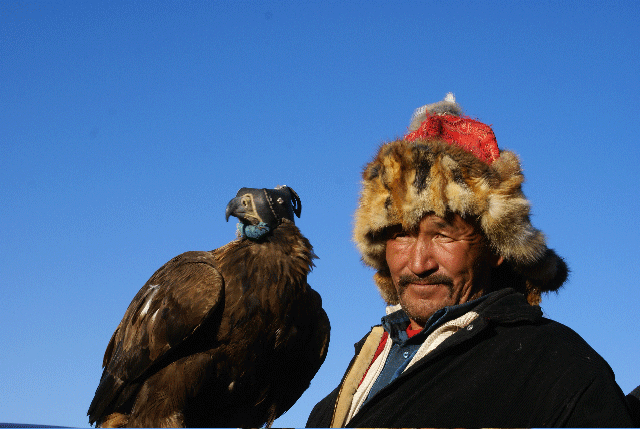
(Photo: Cat Urbigkit)
CURWOOD: It's Living On Earth, I'm Steve Curwood. Although Benjamin Franklin thought the turkey would make an appropriate national emblem for the United States, we wound up with the Bald eagle - hardly a surprise, as eagles have fascinated and inspired humans throughout history. Nature writer Stephen Bodio fell under their spell - and wrote a book that details the complicated place of eagles in a variety of human cultures. The richly illustrated work, called "The Eternity of Eagles", takes us from central Asia, where Kazakh tribes hunt wolves with the help of eagles, to the American West where herders once shot them from aircraft to protect their flocks. Steve Bodio joins us now from Albuquerque, New Mexico. Welcome to Living on Earth, Steve.
BODIO: Glad to be here!
CURWOOD: So, tell me, what makes an eagle, an eagle? I mean, is this just a name or is there some real biological distinction between eagles and the other birds of prey… I’m thinking of goshawks, and harriers, all kinds of birds of prey.
BODIO: The word eagle covers 80-odd species, depending on your taxonomy. We use it in English to mean a number of things – almost more cultural than biological – large bird of prey. We also call various things eagles that might be better called harriers or hawks or giant kites or something completely unique.
On the other hand the truest eagles, the Aquila eagles, the animals we first called eagles, and their relatives, are a very distinct bunch of large, intelligent, active predators, usually with feathered legs. They’re biologically related birds, you know, a natural evolutionary group. So, there’s the essential eagle and there’s the broad constructed concept eagle.
CURWOOD: So, what’s your favorite eagle?
BODIO: My favorite eagle is the Golden Eagle. That’s the eagle that really is eternally, metaphorically with our culture. It is a hunter, an intelligent bird, a bird that has been trained very early by human cultures as a useful and interesting companion. It can live on young herons in the Maritimes or on turtles in Greek islands. It was the Roman war eagle, it was the symbol for that. An enemy to some cultures and a friend to others. It is a universal eagle, I think.
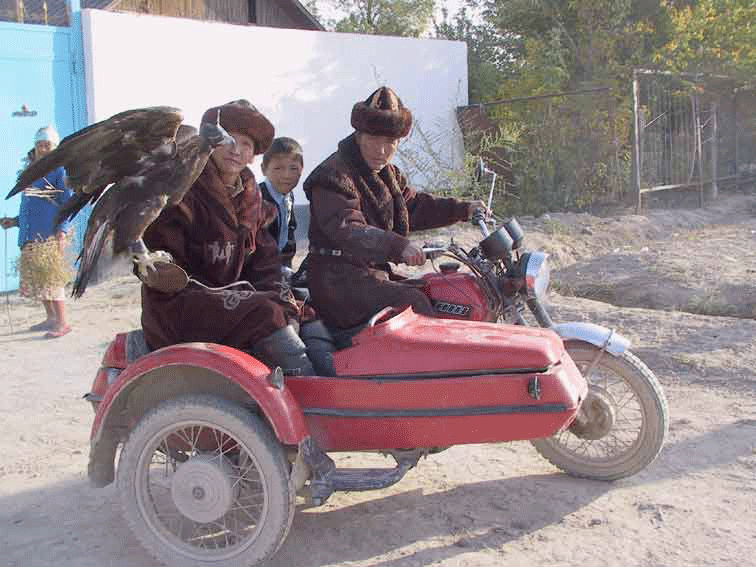
Going hunting outside Nura Village, near Charyn Gorge, Kazakhstan, on Russian motorcycle. (Photo: Wolfgang Regar)
CURWOOD: What is one of your favorite eagles that we may not have heard of?
BODIO: Favorite eagle you may not have heard of, which is barely an eagle but has the name, is the Bateleur of Africa, which is related to the group called snake eagles, but resembles a flying wing. It has almost no tail, huge wings.
In the skies of southern and eastern Africa, there’s always one up, almost like the redtails soaring in the east or turkey vultures in the west, except it’s moving like some sort of science fictional airplane, barely beating its wings but it’s going by at about 60 miles per hour. Rocking slightly on the wind. They cover hundreds of miles per day with barely a flap and they’re very pretty in an exotic way.
CURWOOD: Steve, now, you’ve spent a great deal of time in central Asia, please describe for us how people use eagles to hunt there… and I understand they hunt for wolves?
BODIO: They hunt for wolves. Their day-to-day hunting is probably more for fur animals and for some food animals. Fox is probably the most popular quarry, and that’s very easy, that’s just like a hawk catching a rabbit once they learn how to do it. But wolves are an important stock predator in central Asia and most people don’t have firearms, certainly didn’t have them until the fall of the Soviet Union and an eagle is capable of killing a wolf.
The eagle flies in, quickly grabs the wolf by the muzzle to immobilize its teeth, which are its only weapon, really unlike a cat, and grabs it by the neck or breaks into the chest with its incredibly powerful foot, and basically has it opened in a minute or two – its large blood vessels opened – and kills it very efficiently.
CURWOOD: What brought you to central Asia?
BODIO: A lot of romantic travel people fixated on Africa or on South America, and for some reason I was fascinated with Central Asia from the get-go. I saw a picture of what I now know was a Kazakh herdsman in some magazine when I was about five in Boston.
And the guy was wearing the clothes of a snow leopard and had an eagle on his fist and I just fixated on this and said to myself, not even consciously… I need to see that, I need to go there. And after the Soviet Union fell, I immediately started making queries of friends I knew that traveled… have you seen eagles, have you seen Kazakhs, have you met Kazakhs?
I met a really interesting couple in Brooklyn in Brighton Beach who showed me films of eagles and wolves and got contacts and eventually flew out in February… mid-winter, I wanted to be able to see some hunting, it turned out to be a little late in the season, but better than too early, into Ulaanbaatar, into a night of 40 below zero and then 600 more miles without pavement to Bayan Olgii, the Kazakh state of Mongolia, and a day later I was looking at a hunting eagle perched on a truck tire and knew I had arrived.
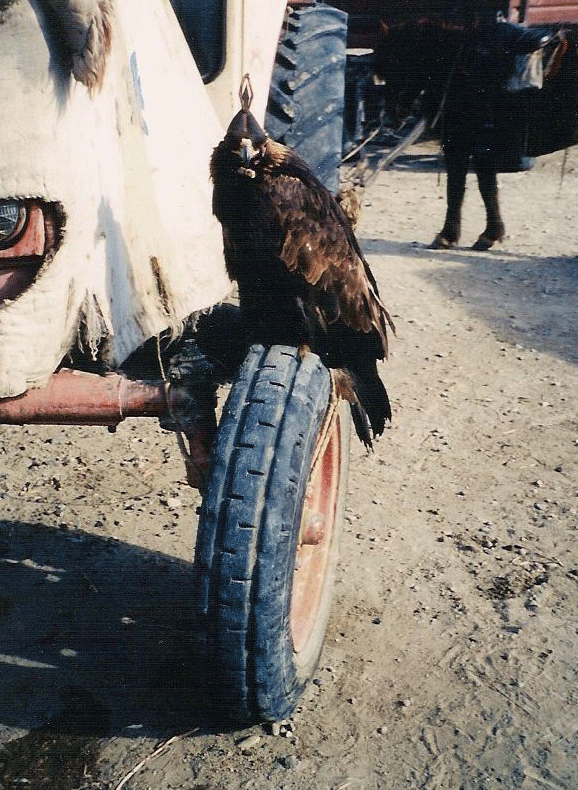
A Kazakh eagle, perched on a tire of a truck in Bayan Nuur outside of Olgii city. Photo: Steve Bodio)
CURWOOD: (Laughs.) On a truck tire, huh?
BODIO: On a truck tire. One of the amusing things, wonderful things of central Asian eagle culture, it’s incredibly pragmatic. Tire makes a great perch, certain synthetics make interesting jesses’ materials, modern sort of high tech outdoor clothing is warm and can be worn underneath your traditional fur robes, and why not? And they’re still doing something they’ve been doing for thousands of years and are happily making use of modern technology. One of the fun photographs in there is a bird riding in a side car of a Russian motorcycle going up and down the streets!
CURWOOD: Now, tell me, how do the Kazakhs train these eagles that they use to hunt?
BODIO: The taming is merely familiarizing. The Kazakhs do one particularly odd thing, they put the bird on what looks like a hammock rolled up - tethered at both ends, and it’s sort of a swinging perch, hooded, to make it have to constantly be changing its grip and a little off-base while they gradually expose it to humans, to children, to dogs, to horses, and to food.
And they feed the bird, which I find interesting, off the point of a knife or out of a bowl rather than their fingers so it’s obviating being bitten or snatched easily. The taming goes like that. And eagles are very intelligent, like most birds of prey, and even as adults tame down really fast.
After each of those training processes, you simply teach, think of teaching a dog… you teach the bird to come when it’s called… here’s the food, whistle, whistle, here’s the food, come on…come on, boy. Or, actually, mostly girl, because, one thing that we haven’t touched on but is commonplace in the bird of prey people - female birds of prey are larger and stronger than the males, almost inevitably.
The more predatory the species, the more likely this dichotomy. Very few males are trained by the Kazakhs, and when I once asked an older Kazakh, perhaps blunter than my friends of my own age, if he ever trained a male and he said ‘do I look like I hunt mice?’
CURWOOD: (Laughs.) So, what was it like to ride with the Kazakh eagle tribes?
BODIO: Completely delightful, they’re the most hospitable people in the world. I could not ride all day, and all day and as fast as these people could. I mean, I didn’t grow up on horseback. But you’d go out in this freezing weather and go out over hill and rock and ice and very little vegetation, just looking for the flight of the fox and you learned to really appreciated boiled mutton and hot tea with butter in it and shots of vodka by the time you came back to the house – as they called their winter-spending place, their adobe houses. I’ll do it as long as I can afford and walk.
CURWOOD: Now, currently, what are the major threats to the world’s eagles?
BODIO: Habitat destruction. And of course the unknown consequences of climactic change. If an eagle has a very small habitat, an island habitat or a marginal habitat, a change could make it very difficult. And I think our classical eagle, our Golden, is not under danger to thrive, it’s likely to outsee our species if we don’t wise up.
But some other eagles with small ranges or threatened habitats – those are the ones that I really worry about. Also, a peculiar, very ambivalent threat, ambivalent in the sense that we are trying to do it for good reasons – wind farms are a real problem for eagles. They’re supposed to be clean energy, but I wonder if the ecological costs of such things on bird populations might be more than we would be willing to pay if we understood them.
CURWOOD: Let’s talk about the future of the eagle. No, better yet, let’s have you read from the very end of your book, the last paragraph that you have.
BODIO: Sure. ‘Eagles will continue to be eagles, splendid, and for the most part, indifferent to our ways. Some of us will always be obsessed with them: love them, hate them, make art or friends of them. They don’t care. They ask nothing but to go on their splendid old dinosaurian way, over our heads, in or out of our minds. They need us less than we need them.

The parade at the annual (September) eagle festival in Olgii. (Photo: Cat Urbigkit)
If we leave them a space, they cannot live in cities (though balds may yet); they may outlive our restless species, as they pre-date us. If they don’t, we may find that many eagles may vanish, leaving only the eagles of the mind that we’ve created in their image. We will be the poorer for it, but I confess, I doubt it will ever happen.
I suspect it’s more likely that Aquila will pass like a shadow over the last human ruins, casting a benign predator’s glance at them as she hunts on down the wind.
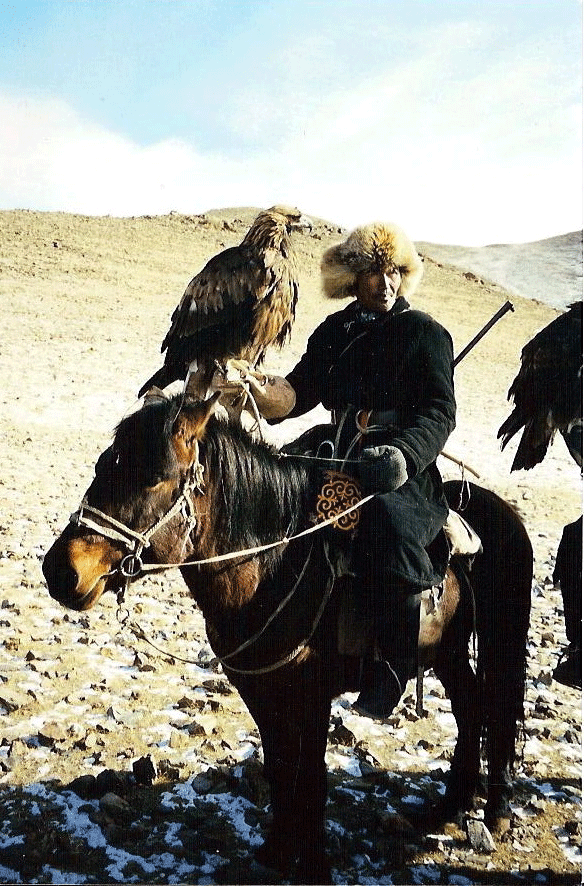
CURWOOD: Stephen Bodio is a writer, naturalist and falconer from New Mexico. His latest book is called: An Eternity of Eagles: The Human History of the Most Fascinating Bird in the World. Thanks so much, Steve!
BODIO: Thank you - this was fun!
Related links:
- Stephen Bodio’s Blog
- An Eternity of Eagles
[Brad Mehldau “The Falcon Will Fly Again” from Highway Rider (Nonesuch Records 2010)]
Greenland Melt Music

Marco Tedesco peers into a crack in the ice sheet (photo: Polar Seeds)
CURWOOD: Well, back in the spring, a team of scientists and artists at the City College of New York came up with a way to listen to glaciers as they melt, as part of a multimedia exhibit about Greenland’s melting ice sheet. To help people understand the science involved, they included photography, video, and a musical method of reflecting the reality of the melting ice. Living on Earth’s Emmett FitzGerald has the story.
FITZGERALD: Every year, Marco Tedesco travels to Greenland to collect data on the annual melt of the ice sheet. He’s a snow and ice scientist, but he has another passion.
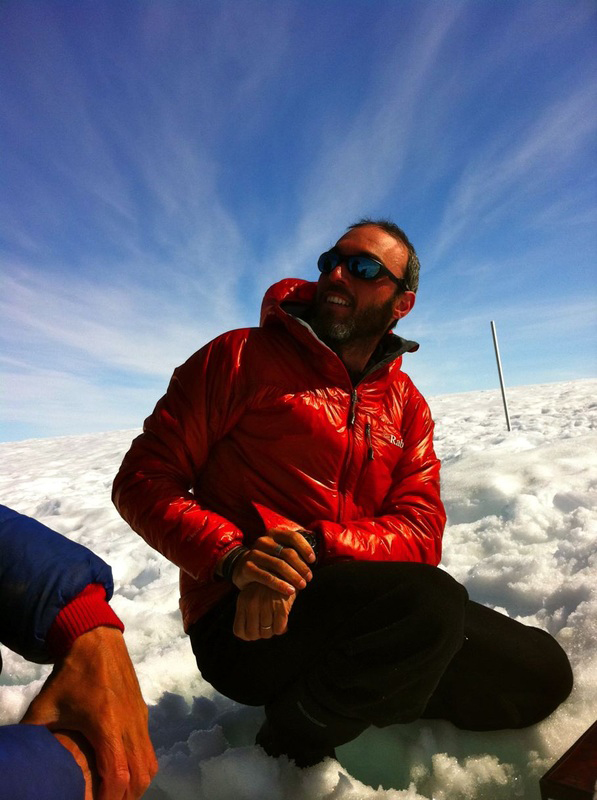
CCNY professor Marco Tedesco in Greenland (photo: Polar Seeds)
TEDESCO: The thing I love more after science, or with science, besides my family, is really music.
FITZGERALD: So when Professor Tedesco found out about City Seeds, a grant program at the City College of New York that funds collaboration between professors from different fields, he saw a chance to combine those two interests. He went to the Music department looking for someone who could turn his data on Greenland’s melting ice into music.
PERL: I’d never done anything like this before at all.
FITZGERALD: That’s Jonathan Perl, a musicologist at CCNY. Although he had no experience sonifying scientific data, Professor Perl was up for the challenge. He did some research of his own.
PERL: I attended the international conference of auditory display and met people who were immersed in representing scientific data with sound.
FITZGERALD: Marco Tedesco says that when it comes to data on Greenland’s melting ice, one of the most important factors is albedo, that’s the capacity of a surface to reflect or absorb solar radiation.
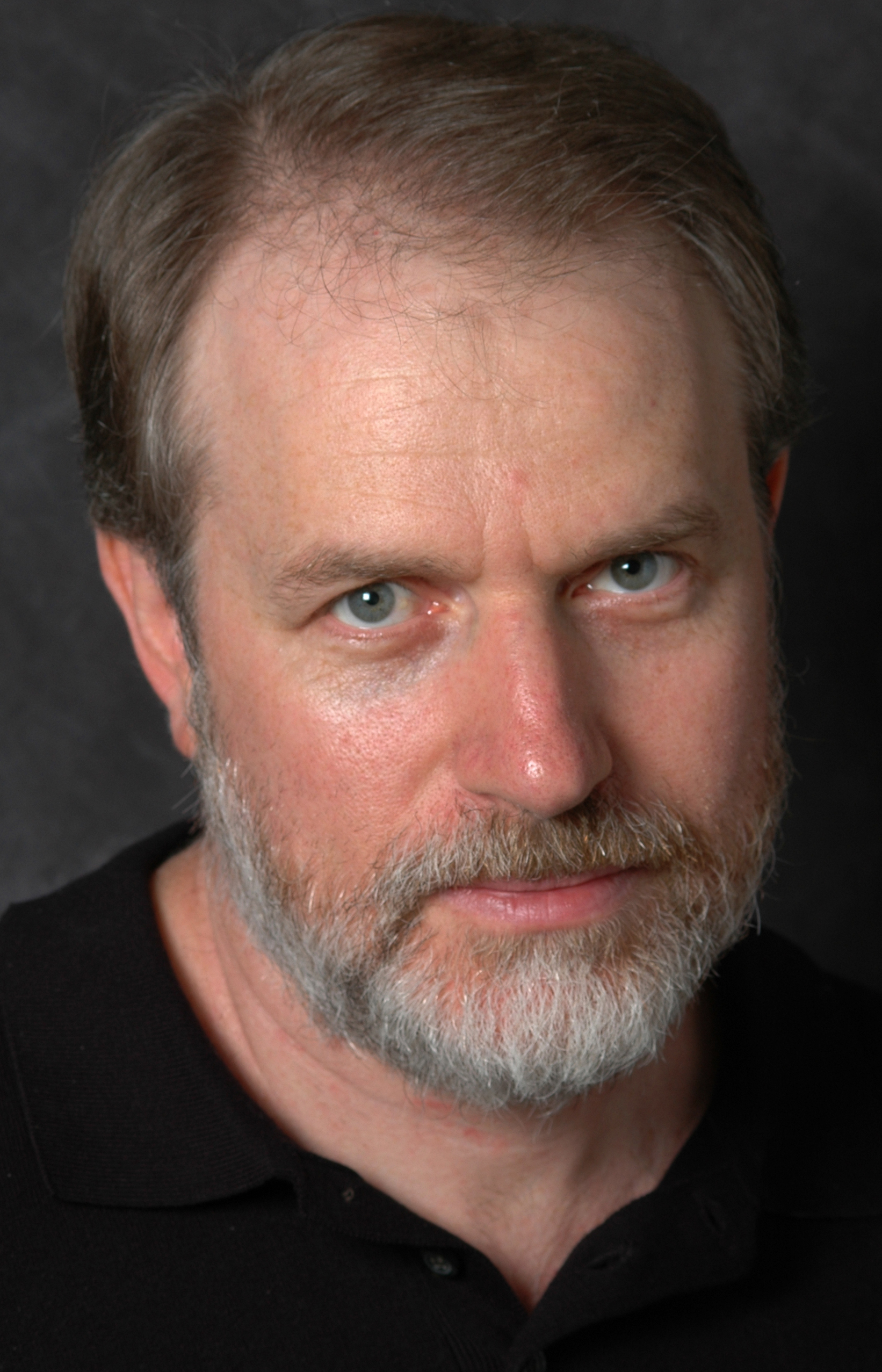
CCNY Music Professor, Jon Perl (photo: CCNY)
TEDESCO: All of us we know albedo in a very empirical way. If you walk in the sun and you’re wearing a black shirt, you’ll get much warmer sooner than your buddy wearing a white shirt.
FITZGERALD: During summer in Greenland, the layer of fresh white snow on the surface begins to melt, exposing older, grayer snow, and eventually blue ice. As the island’s surface grows darker, it absorbs more solar radiation, increasing the overall melt.
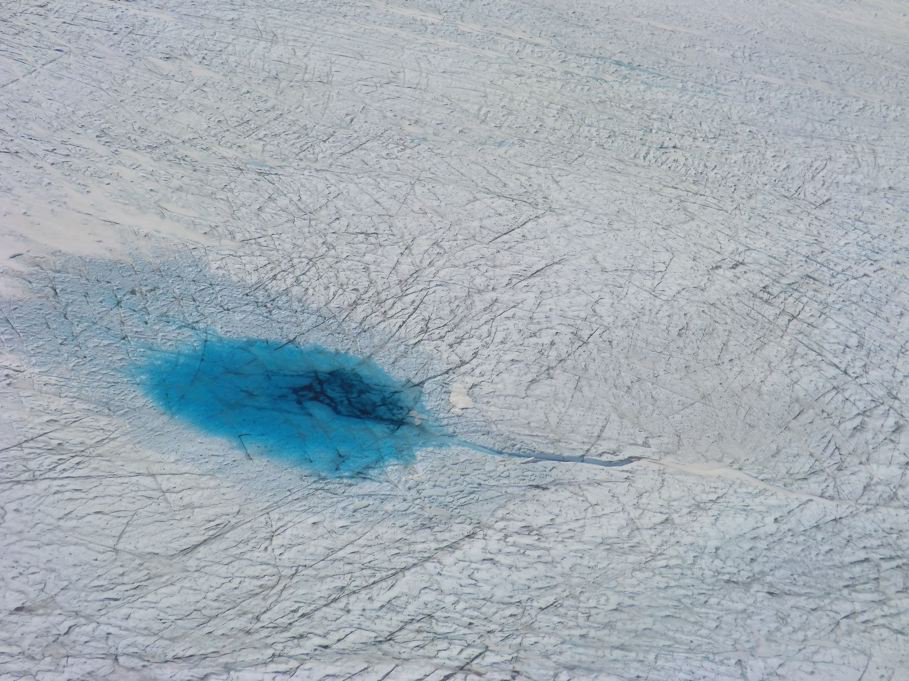
Exposed ice on the Greenland ice sheet. Darker ice surfaces cause the ice sheet to absorb even greater solar radiation. This is called the albedo effect. (photo: Polar Seeds)
TEDESCO: You can see this really as a Shakesperian tragedy. You have the temperature that is a major killer and is trying to kill Lady Greenland. By itself it’s not strong enough, but then you have Mr. Albedo that kicks in right, and then the two guys are accomplices.
FITZGERALD: Rising global temperatures and albedo create a feedback loop that is devastating Greenland’s ice sheet. To illustrate this, Jon Perl sonified albedo and melt rate data. In the mid-1990s, the music sounds fairly calm.
PERL: The technique I used in sonification is called parameter mapping and it basically means representing some aspect of changes in the data with some changes in the sound.
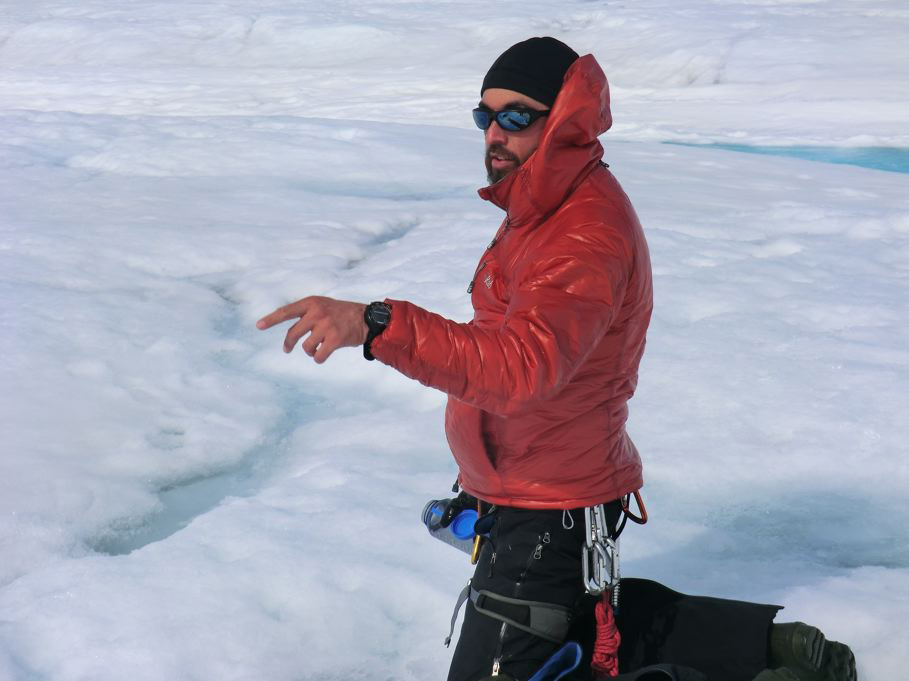
Marco Tedesco wading through glacial melt water (photo: Polar Seeds)
[MUSIC: ALBEDO CHOIR VS MELT RATE GEIGER COUNTER]
PERL: Albedo, I decided to represent that by increasing the intensity of the lower frequencies of a male bass choir. So that as the albedo worsens, as the ice gets darker and is unable to reflect the sunlight the lower voices become more and more intense relative to the high voices in this droning chord.

The Polar Seeds team setting up their exhibit at CCNY (photo: Jon Perl)
[MUSIC CONTINUES UNDER NARRATION]
And the Geiger counter is a well known effect where these very annoying beeps and clicks get louder and more frequent and intense. I decided to use that effect to represent increasing amounts of the ice sheet melting over Greenland.
[MUSIC CONTINUES]

Arial view of Greenland glaciers (photo: Polar Seeds)
It’s a pretty serious problem that’s happening. And I thought more annoying would get the point home.
I think we must be getting into the 2000s now and you can hear the melting is increasing. It gets quite intense. 2012 is a mammoth year.
[MUSIC PEAKS IN INTENSITY AND STOPS]
FITZGERALD: There was record-breaking melt in 2012. Professor Tedesco says it really stands out…
TEDESCO: like a giant basketball player, walking around Times Square.
FITZGERALD: Almost the entire surface of Greenland experienced melting in summer 2012. The overall melting period lasted two months longer than average, and Greenland’s melt alone added a millimeter to the global sea level. To highlight the problem, Professor Perl composed a full summer melt score. It documents the extent of Greenland’s melt over time.

Last summer, Greenland experienced melting over 97% of its surface (photo: Polar Seeds)

Greenland’s melting ice sheet contributed a millimeter to global sea level rise last summer alone (photo: Polar Seeds)
[MUSIC: FULL SUMMER MELT SCORE, RUNS UNDER NARRATION]
PERL: I had a lot of fun with this one. It was pretty challenging to do technically but I figured out a way to compose music so that I could have a continuous performance with a lot of notes that are happening simultaneously. It’s very busy and very frenetic. I took the data, which is the amount of melting, and I have it actually controlling how many of these notes can sound at any given moment.
[MUSIC DIES DOWN TEMPORARILY]
PERL: There was a spot with very minimal melting. That was the lowest amount of melting that happened in that time scale. So, essentially when the melting values are low it suppresses the playback of most of the notes. And then as the melting values rise in real time it allows more notes to be allowed basically through this gate, to be allowed to play.
[MUSIC CONTINUES]
PERL: The time scale we are hearing here is three seconds represent about a year’s worth of change. It’s not till the very end, which we are getting pretty close to, 2013, where you can pretty much hear the full musical score where all the notes are playing.
PERL: I’d actually done a prior version of this before I had the 2012 values, and the whole arrangement was kind of more intense, but as soon as I rescaled everything and added 2012, all the other years kind of paled in comparison.
[MUSIC PEAKS AND STOPS]
FITZGERALD: Jon Perl has worked in all sorts of musical styles - from experimental jazz, to rock and roll. But he says he’s never heard anything quite like his glacial melt music. That may be because he had an unusual collaborator - the data.
PERL: I mean I know that I didn’t compose this piece entirely, its kind of composing itself by having the melting values determine what notes are playing at any given time and what notes aren’t.
FITZGERALD: In the end, the two professors presented the sonifications as part of an exhibit they called PolarSeeds. For Professor Tedesco, it was an exciting change of venue for his research.
TEDESCO: Usually my work finalizes in papers, publications, or conferences. So to be able to put together my results in an exhibit was very satisfying for me.
FITZGERALD: He hopes the songs, photos, and videos will reach a broader audience than a scientific paper, and thinks that could be a good thing. Greenland’s melting ice sheet is fast becoming a serious global problem.
TEDESCO: It’s very important for us to understand that what happens in the Arctic, what happens in Greenland doesn’t stay really in Greenland.

Marco Tedesco wading through glacial melt water (photo: Polar Seeds)
FITZGERALD: Greenland’s contribution to sea level rise will affect people living near coasts all around the world. Professor Perl hopes the glacial melt music can affect how people think about global warming and its impacts.
PERL: When you take the time to actually listen to it, you experience what’s actually happening in a way that is more visceral, and has a different kind of impact then if you just look at a graph.
FITZGERALD: There are thousands of global warming graphs and statistics out there, but given what 2012 sounded like, hearing climate change may bring the message home.
For Living on Earth, I’m Emmett FitzGerald.
Related links:
- Polarseeds website
- Marco Tedesco’s website Greenland Melting
- Marco Tedesco’s faculty page
- Jonathan Perl’s faculty page
- Video illustrating the albedo effect
[MUSIC: Dave Douglas “Dog Star” from Moonshine (Koch Records 2008)]
CURWOOD: Living on Earth is produced by the World Media Foundation. Naomi Arenberg, Bobby Bascomb, Emmett Fitzgerald, Helen Palmer, Poncie Rutsch, Erin Weeks, Adelaide Chen, James Curwood, Jennifer Marquis and Gabriela Romanow all help to make our show. Jeff Turton is our technical director. Alison Lirish Dean composed our themes. You can find us anytime at LOE.org, and check out our Facebook page, it’s PRI’s Living on Earth. And we tweet from @LivingOnEarth. I'm Steve Curwood. Thanks for listening.
ANNOUNCER 1: Funding for Living on Earth comes from the Grantham Foundation for the protection of the environment. Supporting strategic communications and collaboration in solving the world’s most pressing environmental problems. The Kendeda Fund, furthering the values that contribute to a healthy planet, and Gilman Ordway for coverage of conservation and environmental change. Living on Earth is also supported by a friend of The Nation where you can read such environmental writers as Gwen Stevenson, Bill McKibben, Mark Hertsgaard and others at The Nation dot com. This is PRI, Public Radio International.
ANNOUNCER 2: PRI, Public Radio International.
Living on Earth wants to hear from you!
Living on Earth
62 Calef Highway, Suite 212
Lee, NH 03861
Telephone: 617-287-4121
E-mail: comments@loe.org
Newsletter [Click here]
Donate to Living on Earth!
Living on Earth is an independent media program and relies entirely on contributions from listeners and institutions supporting public service. Please donate now to preserve an independent environmental voice.
NewsletterLiving on Earth offers a weekly delivery of the show's rundown to your mailbox. Sign up for our newsletter today!
 Sailors For The Sea: Be the change you want to sea.
Sailors For The Sea: Be the change you want to sea.
 The Grantham Foundation for the Protection of the Environment: Committed to protecting and improving the health of the global environment.
The Grantham Foundation for the Protection of the Environment: Committed to protecting and improving the health of the global environment.
 Contribute to Living on Earth and receive, as our gift to you, an archival print of one of Mark Seth Lender's extraordinary wildlife photographs. Follow the link to see Mark's current collection of photographs.
Contribute to Living on Earth and receive, as our gift to you, an archival print of one of Mark Seth Lender's extraordinary wildlife photographs. Follow the link to see Mark's current collection of photographs.
 Buy a signed copy of Mark Seth Lender's book Smeagull the Seagull & support Living on Earth
Buy a signed copy of Mark Seth Lender's book Smeagull the Seagull & support Living on Earth

